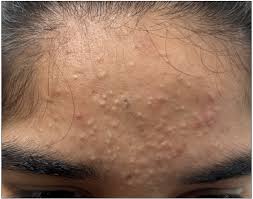Excessive sebum production is a common dermatological concern, particularly among adolescents and young adults, leading to oily skin, shiny appearance, and contributing to the development of comedones and inflammatory acne lesions. The demand for effective and safe solutions, especially those derived from natural sources, has been steadily increasing within the cosmetic industry. This study by Lozada et al. addresses this issue by evaluating the safety and sebum-controlling efficacy of a novel cosmetic elastomer formulated with vegetable seed oils from Peruvian biodiversity, specifically Plukenetia huayllabambana, Physalis peruviana L., and Bertholletia excelsa. These oils were selected due to their high content of linoleic acid, a fatty acid known to play a crucial role in maintaining the epidermal barrier and whose deficiency is associated with increased sebum secretion and acne development. The utilization of a cosmetic elastomer as a delivery system is also noteworthy, as these silicone polymers can incorporate high levels of oils and provide a mattifying effect upon application.
Methods:
The study comprised two main evaluations: a 3-week safety assessment involving dermatological examinations and the calculation of a skin irritation index on 24 volunteers, and an in vivo instrumental efficacy evaluation for sebum control on three groups of volunteers (n=6, 8, and 10) with oily skin. Sebum levels were quantitatively measured on the forehead using a Sebumeter® SM 815 at baseline and 2, 4, and 5 hours after a single application of the cosmetic elastomer to one side of the forehead, with the other side serving as an untreated control. Statistical analysis using t-tests was conducted to compare sebum levels between the treated and untreated areas at each time point.
Key Findings:
•The cosmetic elastomer demonstrated excellent safety for daily use, with a mean skin irritation index of 0.00, indicating it as nonirritating and very well-tolerated by the participants.
•The instrumental efficacy evaluation revealed a significant reduction (p < 0.05) in sebum levels in the areas treated with the elastomer compared to the untreated areas in all three volunteer groups at 2, 4, and 5 hours post-application.
•The third group of volunteers exhibited the highest percentage reductions in sebum, achieving 43.48% at 2 hours, 52.43% at 4 hours, and 43.95% at 5 hours.
•Dermatological observation during the safety study also noted an improved control of sebum and seborrhea in the application areas of all participants.
This research presents a novel cosmetic formulation based on a cosmetic elastomer incorporating vegetable oils derived from Peruvian biodiversity that has been scientifically validated for both its safety and its efficacy in controlling sebum production. The study’s findings highlight the potential of utilizing the unique fatty acid profiles of Plukenetia huayllabambana, Physalis peruviana L., and Bertholletia excelsa oils within a silicone matrix to address the persistent issue of oily skin. The demonstrated significant reduction in sebum levels, coupled with the product’s non-irritating nature, suggests a promising alternative for individuals seeking to manage facial oiliness using natural ingredients. Future research could explore the long-term effects of this formulation on sebum control with daily use over several weeks, as well as its potential benefits in the management of acne vulgaris given the link between sebum overproduction and acne pathogenesis. This study lays the groundwork for the development of innovative and safe natural cosmetic products targeting sebum control and potentially contributing to improved skin health and appearance.
Link to the study: https://www.mdpi.com/2079-9284/12/2/66

